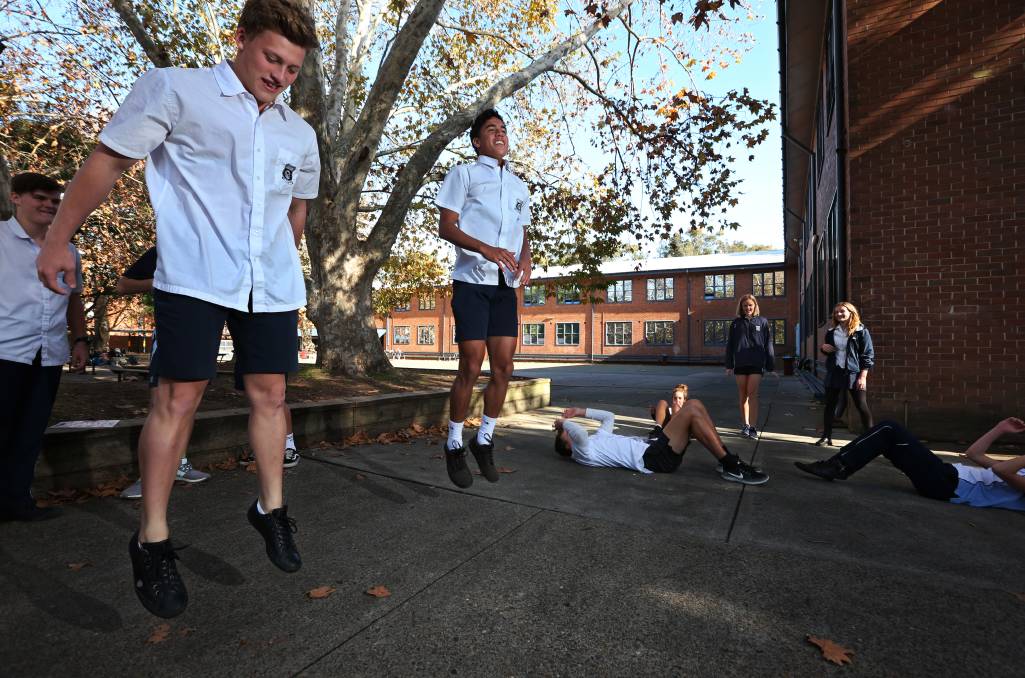Burn 2 Learn school exercise program boosts adolescent fitness and health
A world first school-based physical activity program tailored to adolescents is improving the cardiorespiratory fitness and wellbeing of young people by supporting their engagement in short High Intensity Interval Training.

Less than 20 percent of young people meet the National Physical Activity Guidelines of at least 60 minutes in a 24-hour period. In fact, Australian children and adolescents are some of the least physically active in the world. That’s the upshot of the 2022 Australian Physical Activity Report Card, commissioned by Active Healthy Kids Australia. In addition, in years 11 and 12, physical education and school sport are no longer compulsory, so physical activity may drop even further at this stage.
To help address these issues, the Hunter Medical Research Institute (HMRI) collaborated with the NSW Department of Education, University of Newcastle’s Centre for Active Living and Learning, Australian Catholic University, and Northeastern University, to develop a time-efficient physical activity program for senior school students. More than 325 teachers from 218 schools have now been trained to deliver the Burn 2 Learn program, reaching approximately 18,900 students. NSW Health, through the Office for Health and Medical Research (OHMR) provided funding for on-going infrastructure to the Hunter and Medical Research Institute, via the Medical Research Support Program.
Countering screen time
Flashback to the 1950s and ‘60s and at the end of the school day, children spent hours playing outdoor games such as hopscotch, ‘chasies’, cricket, skip-rope and totem tennis. Space hoppers and Hula hoops also kept kids on the go for hours until they were called in for dinner. Cut to the present and after school, young people often head indoors where a great deal of leisure time is spent texting, gaming, checking social media platforms, surfing the net or streaming the latest trending TV series. Completing homework tasks often involves further use of a digital device or computer, especially in the upper years of high school. At the same time, study commitments and weekend jobs can lead young people to drop sports such as soccer, swim squad and netball.
The Burn 2 Learn program evolved to counter this sedentary time and encourage young people to set new attainable exercise habits to benefit their current and future mental and physical health. In addition to impacting the wellbeing of children today and tomorrow, increasing physical activity at the population level will help to reduce the estimated $555 million annual economic burden of physical inactivity in Australia.
Stepping up at school
Schools are one of the most important settings for the promotion of physical activity amongst children and adolescents. They have sporting equipment and designated areas such as school ovals, halls and gyms, where students can engage in physical activity. “The Burn 2 Learn program was designed to harness the opportunities of physical activity that school settings can provide,” says Professor David Lubans, Deputy Director of the University of Newcastle’s Centre for Active Living and Learning and a Senior Executive in the Hunter Medical Research Institute’s Active Living Research Program. “The end result was a world first teacher-facilitated physical activity program tailored for older adolescents aged 15-19 years.”
Students participating in the program enjoyed access to a workout library and videos which guided their High Intensity Interval (HIIT) workouts. They could choose from a variety of 12 pre-designed workout options. This choice allowed some autonomy over their exercise sessions and also helped to counter workout boredom. To encourage social support in the program, students completed the sessions together as a class, but were also self-directed in their workout. A heartrate monitor was required during each session to log their data.
Short, sharp activity sessions
“Burn 2 Learn utilises the science of High Intensity Interval Training (HIIT) to improve the health, fitness, wellbeing, and classroom behaviour of senior school students, using short but impactful workouts,” says Lubans. “HIIT workouts involve repeated short bouts of intense exercise to increase the heartrate. These intervals are followed by short periods of rest.” The Burn 2 Learn program includes a variety of pre-designed HIIT workouts, including Gym HIIT, Sport HIIT, Hip Hop HIIT, Combat HIIT, Class HIIT (which can be done inside a classroom), and a short option known as Quick HIIT for days when time at school is more limited. Each session lasts around 10 minutes with exercise intervals of 30 seconds followed by a ‘rest’ period of 30 seconds where students can stand still, or walk/ jog on the spot.
To ensure and facilitate student exercise access, the Burn 2 Learn program utilises an app which has many different features that help keep adolescent students informed and engaged. The app and program enable them to:
- Complete a solo session or compete against up to five friends in a group session
- Receive personalised post-workout reports showing heart rates achieved during each interval during the workout
- Synch with heart rate monitors for real-time feedback which allows the student to see if they are performing exercise at 85% of their maximum heart rate to stay in the high intensity zone
- Customise their workouts by changing the work-to-rest ratio and number of intervals they are aiming for in their workout
- View their exercise stats on a dashboard display that shows the sessions they have completed, average heart rate across workouts, number of wins against friends, age-predicted maximum heart rate, and highest heart rate achieved
- View a calendar display showing total sessions completed each week
- Link to multiple de-identified user results using a unique group session code for the whole class.
Assessing exercise impacts of Burn 2 Learn
The Burn 2 Learn program was refined through consultations with the NSW Department of Education, Hunter Medical Research Institute (supported by NSW Health), teachers, and students, leading to two pilot studies. Building on the feedback from the initial studies and consultations, the research team conducted a randomised control trial in 20 schools, involving 720 students aged 12-18 (funded by National Health and Medical Research Council). Teachers in schools adopting the Burn 2 Learn intervention were provided with training, resources, and support to facilitate the delivery of high-intensity interval training (HIIT) activity breaks during curriculum time. In the control group, teachers and students engaged in their usual routine.
In phases I and II of the study, (which each ran for three months), teachers facilitated the delivery of at least two HIIT sessions a week during lesson-time. In phase III at the six month and primary end point of the study, students were encouraged to complete sessions outside of lesson-time (with teachers also able to continue to facilitate the delivery of Burn 2 Learn sessions during lesson-time). The study assessed change in cardiorespiratory fitness via a 20-minute multi-stage fitness test for each student after six months on the program. Secondary outcomes of the research also tracked muscular fitness, physical activity, cortisol levels, mental health and wellbeing and cognitive function. All of these outcomes were assessed at baseline, six months (the primary end-point) and 12 months. At the end of the research period a process evaluation was conducted to assess recruitment, retention, attendance and program satisfaction.

Brain and body benefits
“The Burn 2 Learn program led to significantly enhanced cardiorespiratory fitness in older adolescents,” Lubans says. “Secondary benefits included improvements in muscular fitness, increased physical activity during the school day (measured using accelerometers which track acceleration of motion), and increased confidence to participate in HIIT. A subset of students also provided hair samples to determine their accumulated exposure to stressful events. This information confirmed that short, high-intensity exercise also significantly reduces levels of the stress hormone, cortisol.”
Although mental health did not improve in the full study sample, the research team found improvements in students who were experiencing poor mental health at baseline, and in those classified as overweight or obese. The sub-group analyses were pre-specified and helped demonstrate the benefits of the program amongst students most at risk of mental illness.
As part of the research, a subset of 60 adolescents with lower fitness levels were studied using magnetic resonance spectroscopy. These brain scans were conducted at baseline and then again after six months. “The findings strongly suggested that physical activity may improve hippocampal metabolism in lower fit older adolescents,” says Lubans. “As the hippocampus substantially impacts learning and memory in the brain, improvements in function of this brain region indicate that HIIT workouts can help improve working memory in young people.”
Exercise support for students with disability
A group of special education teachers saw the benefits of the Burn 2 Learn program and approached the research team to request a similar program for their students with disabilities. This led the team to partner with the NSW Department of Education and Special Olympics Australia to co-design the Burn 2 Learn adapted program for students with disability. This research involved 270 older adolescents with a diagnosed disability (any type) from 28 secondary schools in NSW. The cluster randomised trial was conducted in 2022 to 2023 and the findings will be published later this year.
Rolling out the Burn 2 Learn program
Burn 2 Learn demonstrated significant success in improving the physical and mental wellbeing of older adolescents. Its effectiveness across various areas of health and fitness, underscores its potential as a practical and transformative intervention in school settings. Looking ahead, says Lubans, “There are currently plans to evaluate an optimised version across multiple Australian states so that more students can benefit from the diverse mind and body impacts of the program.”
Updated 6 months ago